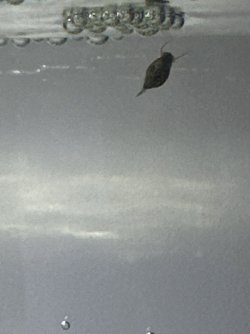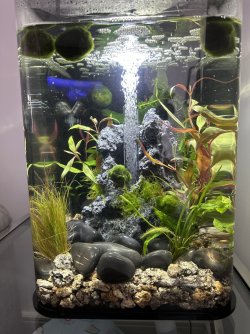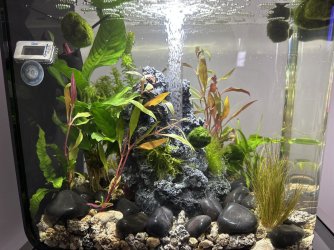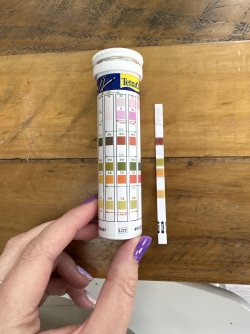So you got an amano?i feel bad for him, he’s on his own and he has no food. what am i to do with him?
lol my brother has a cockatoo so i know exactly what you mean! i don’t want any version of that lol aww sorry about ur chilli rasbora
🌟 Exclusive Amazon Black Friday Deals 2024 🌟
Don’t miss out on the best deals of the season! Shop now 🎁
You are using an out of date browser. It may not display this or other websites correctly.
You should upgrade or use an alternative browser.
You should upgrade or use an alternative browser.
Any guidance welcome
- Thread starter alio6
- Start date
-
- Tags
- biorb flow plant advice
mine was fully grown and way bigger than my cherry shrimp and chilli rasboras. If you've got a bigger tank and bigger inhabitants then it will be fine, but I suppose, depending on what fish you have, it's possible that they may become snacks.I enjoy my amanos. Mine aren't as active as yours though. I just got a couple yesterday. Very small. I'm hoping I didn't buy an expensive snack for my fish.
no i have no idea what he is. he just came in on a plant. are you responding to the wrong comment ? i thinkSo you got an amano?
sorry only just seen this. no the ceramic media works as a biological filter and you have to use it, doesn’t get sludgy from what i’m led to believe and can’t use anything else as it would clog the filterI've been investigating a bit more and it looks to me like the filter works like a box filter. I had initially assumed that the water entered the filter housing through the sides and/or underneath. But it looks to me like the water enters through the top plate, so it's really just an air driven box filter. There will be incidental flow of water through the substrate, but only because of general turbulence, and not in the same way as with an undergravel filter. Therefore I think you could probably replace the substrate with sand which I think would a be a lot healthier for your aquarium. By using the substrate that came with the biorb you'll end up with a load of sludge trapped down there in no time. I'd recommend maidenhead aquatics speckled sand.
https://www.fishkeeper.co.uk/aqua-s...43715&indexName=magento2_livedefault_products
It does need a LOT of rinsing though!
I may be entirely wrong in this though. the water inlets may be on the sides/underneath. Ali, are you able to advise?
no i don’t know what he is he just came in on a plantSo you got an amano?
sorry i keep missing msgs! yeh i saw this on you tube about leaves. i think i’ll wait until i’m more confident with what i’m doing before i enter the shrimp game. they look so cool though. i really liked my old catfish. he was my favouritecherry shrimp are easy to feed so you don't need algae in your tank to sustain them. They'll eat pretty much any fish food - flake, granules, algae wafers, catfsh pellets. The only problem with your substrate being the way it is, is that uneaten food will very easily get lodged deep down into the substrate so may be out of reach of the shrimp. With sand, the uneaten food stays on top, so the shrimp scavenge it up in a jiffy. If you keep shrimp I'd recommend feeding your fish very carefully so there is minimal uneaten food (a good thing to do in general but particularly important with your substrate/filter) and put in blanched veg such as broccoli for the shrimp. They will also eat cattapa leaves. I put a large cattapa leaf in and it takes about a week before it is soft enough for the shrimps to be able to eat it, and then it is reduced to a skeleton over the course of another week.
Oh, you mean the snail! your tank is essentially sterile at the moment so there has been no chance for any algae or biofilm to develop, so nothing for it to eat. However, if you are about to commence a fishless cycle then you will get an ammonia spike followed by a nitrite spike, so the snail may well not survive that.no i have no idea what he is. he just came in on a plant. are you responding to the wrong comment ? i think
can i do a fish cycle? see pic of snail for infoOh, you mean the snail! your tank is essentially sterile at the moment so there has been no chance for any algae or biofilm to develop, so nothing for it to eat. However, if you are about to commence a fishless cycle then you will get an ammonia spike followed by a nitrite spike, so the snail may well not survive that.

No, don't do a fish in cycle. I'd remove the snail. I've no idea what type it is, whether or not it'll survive a cycle, whether or not it can reproduce asexually, whether or not it'd eat plants, how much it will reproduce etc. If it survives you could find yourself with a big pest snail problem. Nerite snails are unable to reproduce in fresh water and do not eat plants, so you know what you are getting, so if you want a snail or two in your tank once it's cycled I'd got for nerites.can i do a fish cycle? see pic of snail for info View attachment 322991
ok thanks i will!No, don't do a fish in cycle. I'd remove the snail. I've no idea what type it is, whether or not it'll survive a cycle, whether or not it can reproduce asexually, whether or not it'd eat plants, how much it will reproduce etc. If it survives you could find yourself with a big pest snail problem. Nerite snails are unable to reproduce in fresh water and do not eat plants, so you know what you are getting, so if you want a snail or two in your tank once it's cycled I'd got for nerites.
poor little guy. but i’ll get rid
the biorb ppl came back to light is only 80 degrees so ur right it’s crap lol but hey ho it looks smart and if i do get really into this fish marlarky again i’ll get another tank! and i’ll be sure to ask you all about what’s best then if you’re happy to down the line
No problem. good luck with it all.ok thanks i will!
poor little guy. but i’ll get rid
the biorb ppl came back to light is only 80 degrees so ur right it’s crap lol but hey ho it looks smart and if i do get really into this fish marlarky again i’ll get another tank! and i’ll be sure to ask you all about what’s best then if you’re happy to down the line
It's one of those pest snails that have a few names - pond snail, trapdoor snail, bladder snails etc. They come in on plants, either as snails or snail eggs. A lot of people hate them and will do anything to get rid of them. There will be more you haven't seen yet, or their eggs - tiny things in clear jelly and very hard to see. You can get rid of them when you see them, or leave them there. Unlike the snails we have to buy, the various species of pest snails are indestructible. I have these and another pest snail in both my tanks, and the freshwater limpets Mikeyboy mentioned in my shrimp tank, they are not bad, they are an important part of a tank's ecosystem, but their numbers can increase rapidly which when they're a problem. Once you have fish the secret is not over feeding them as that's what the pest snails eat, uneaten fish food and bits of dead plant. With the snails, the more food they have the more they breed. Fish need a lot less food than you'd think. Mammals like us use a lot of the food we eat to maintain our body temperature. Fish get their body heat from the water so they need less food than we do. A lot less.
We've talked about cycling. There are three methods - fishless, fish-in and plant.
Fish-in is not good as the ammonia and nitrite in the water during cycling harms the fish and can kill them. That leaves fishless and plant.
Fishless involves adding ammonia to the tank to grow the necessary bacteria colonies before fish are put in the tank.
Plant cycling uses plants to remove the ammonia made by the fish, and they don't turn it into nitrite.
You already have plants in the tank, so adding ammonia is not a good idea as the fishless cycling process involves adding ammonia all at once in a single dose and many plants are damaged by doing this. Fish make ammonia in tiny amounts 24 hours a day. The total amount may be the same but it's not added in one dose.
That leaves plant cycling. I suggest you take a photo of the tank, then wait a couple of weeks. Then compare the tank to today's photo. Look to see if the plants have grown, and whether it's a good amount or just a tiny bit. When the plants are obviously growing, it is safe to add fish. Floating plants are particularly good at taking up ammonia as they are near the lights and they can get carbon dioxide from the air, both of which they need to grow as well as ammonia which is why we suggest leaving some elodea floating.
While the plants are growing, we can talk about fish
We've talked about cycling. There are three methods - fishless, fish-in and plant.
Fish-in is not good as the ammonia and nitrite in the water during cycling harms the fish and can kill them. That leaves fishless and plant.
Fishless involves adding ammonia to the tank to grow the necessary bacteria colonies before fish are put in the tank.
Plant cycling uses plants to remove the ammonia made by the fish, and they don't turn it into nitrite.
You already have plants in the tank, so adding ammonia is not a good idea as the fishless cycling process involves adding ammonia all at once in a single dose and many plants are damaged by doing this. Fish make ammonia in tiny amounts 24 hours a day. The total amount may be the same but it's not added in one dose.
That leaves plant cycling. I suggest you take a photo of the tank, then wait a couple of weeks. Then compare the tank to today's photo. Look to see if the plants have grown, and whether it's a good amount or just a tiny bit. When the plants are obviously growing, it is safe to add fish. Floating plants are particularly good at taking up ammonia as they are near the lights and they can get carbon dioxide from the air, both of which they need to grow as well as ammonia which is why we suggest leaving some elodea floating.
While the plants are growing, we can talk about fish
yes i have removed the snail we found, i googled and it looked like a bladder snail. hopefully there won’t be many more.It's one of those pest snails that have a few names - pond snail, trapdoor snail, bladder snails etc. They come in on plants, either as snails or snail eggs. A lot of people hate them and will do anything to get rid of them. There will be more you haven't seen yet, or their eggs - tiny things in clear jelly and very hard to see. You can get rid of them when you see them, or leave them there. Unlike the snails we have to buy, the various species of pest snails are indestructible. I have these and another pest snail in both my tanks, and the freshwater limpets Mikeyboy mentioned in my shrimp tank, they are not bad, they are an important part of a tank's ecosystem, but their numbers can increase rapidly which when they're a problem. Once you have fish the secret is not over feeding them as that's what the pest snails eat, uneaten fish food and bits of dead plant. With the snails, the more food they have the more they breed. Fish need a lot less food than you'd think. Mammals like us use a lot of the food we eat to maintain our body temperature. Fish get their body heat from the water so they need less food than we do. A lot less.
We've talked about cycling. There are three methods - fishless, fish-in and plant.
Fish-in is not good as the ammonia and nitrite in the water during cycling harms the fish and can kill them. That leaves fishless and plant.
Fishless involves adding ammonia to the tank to grow the necessary bacteria colonies before fish are put in the tank.
Plant cycling uses plants to remove the ammonia made by the fish, and they don't turn it into nitrite.
You already have plants in the tank, so adding ammonia is not a good idea as the fishless cycling process involves adding ammonia all at once in a single dose and many plants are damaged by doing this. Fish make ammonia in tiny amounts 24 hours a day. The total amount may be the same but it's not added in one dose.
That leaves plant cycling. I suggest you take a photo of the tank, then wait a couple of weeks. Then compare the tank to today's photo. Look to see if the plants have grown, and whether it's a good amount or just a tiny bit. When the plants are obviously growing, it is safe to add fish. Floating plants are particularly good at taking up ammonia as they are near the lights and they can get carbon dioxide from the air, both of which they need to grow as well as ammonia which is why we suggest leaving some elodea floating.
While the plants are growing, we can talk about fish
plant cycling it is! here is todays pic.
thanks
Attachments
i just had a look at my hardness again and by the look of this test done moments ago it’s harder that what the utility company is leading us to believe. what do you think ?It's one of those pest snails that have a few names - pond snail, trapdoor snail, bladder snails etc. They come in on plants, either as snails or snail eggs. A lot of people hate them and will do anything to get rid of them. There will be more you haven't seen yet, or their eggs - tiny things in clear jelly and very hard to see. You can get rid of them when you see them, or leave them there. Unlike the snails we have to buy, the various species of pest snails are indestructible. I have these and another pest snail in both my tanks, and the freshwater limpets Mikeyboy mentioned in my shrimp tank, they are not bad, they are an important part of a tank's ecosystem, but their numbers can increase rapidly which when they're a problem. Once you have fish the secret is not over feeding them as that's what the pest snails eat, uneaten fish food and bits of dead plant. With the snails, the more food they have the more they breed. Fish need a lot less food than you'd think. Mammals like us use a lot of the food we eat to maintain our body temperature. Fish get their body heat from the water so they need less food than we do. A lot less.
We've talked about cycling. There are three methods - fishless, fish-in and plant.
Fish-in is not good as the ammonia and nitrite in the water during cycling harms the fish and can kill them. That leaves fishless and plant.
Fishless involves adding ammonia to the tank to grow the necessary bacteria colonies before fish are put in the tank.
Plant cycling uses plants to remove the ammonia made by the fish, and they don't turn it into nitrite.
You already have plants in the tank, so adding ammonia is not a good idea as the fishless cycling process involves adding ammonia all at once in a single dose and many plants are damaged by doing this. Fish make ammonia in tiny amounts 24 hours a day. The total amount may be the same but it's not added in one dose.
That leaves plant cycling. I suggest you take a photo of the tank, then wait a couple of weeks. Then compare the tank to today's photo. Look to see if the plants have grown, and whether it's a good amount or just a tiny bit. When the plants are obviously growing, it is safe to add fish. Floating plants are particularly good at taking up ammonia as they are near the lights and they can get carbon dioxide from the air, both of which they need to grow as well as ammonia which is why we suggest leaving some elodea floating.
While the plants are growing, we can talk about fish
Attachments
Looking at the strip, there are two together at the top (nitrite and nitrate?) then a single one marked in degrees, then two more together, one of which looks like pH and the other marked in degrees. Of the two marked in degrees, which is GH and which KH?
I'd go with the water company, they have expensive equipment rather than strips to test with.
I'd go with the water company, they have expensive equipment rather than strips to test with.
Similar threads
- Replies
- 12
- Views
- 464
- Replies
- 28
- Views
- 722
- Replies
- 0
- Views
- 80





